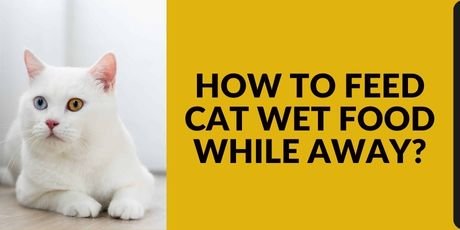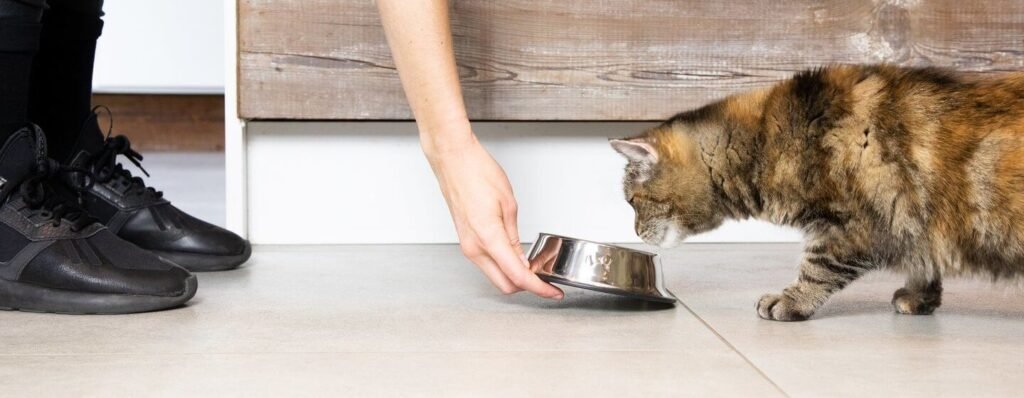For those who like their fur babies, having to leave for business trips, vacations, day trips, or emergencies is a reality. One of the reasons you may worry while away from home for a week or so is how to feed your furry children their preferred wet food. This can be a problem if your kitty hasn’t been taught to pop open a can by themselves, but there are options to consider that avoid disturbing their routine.
You wouldn’t want to return home to a stinky war zone. Relying solely on dry food might be a solution, but several factors need consideration: your cat’s relationship with food, the duration of your trip, their current diet, and any sensitivities to different types of food.
It’s important to learn about the right type of food to feed your cat. I’ve seen many videos and even stopped feeding my cats dry food after noticing health complications. There are many ideas you can post about, and I have personally tried several, each with its own pros and cons.
In this blog post, we’ll discuss how to feed your cats wet food while you’re away, based on hands-on field experience with my own 4 kitty monsters. Expect reliable, unbiased, and research-based cat care guides, with additional tips sprinkled throughout.
Freeze Wet Food to Thaw during the Day
When you’re gone for the day and miss your cat’s regularly scheduled feeding, try a setting up a time-release freezer bomb of wet food. This allows your fuzzy child to enjoy their meal at the right time.
Remember, cats don’t like cold food; they prefer it at room temperature. There’s a risk they might crack a tooth on a brick of frozen fish-stuff, so ensure it’s thawed properly.

Reasons to Feed Your Cat Wet Food While Away
Feeding your cat exclusively wet food while you’re away has its advantages. If you stop feeding them wet food when you’re absent, switching suddenly or cutting off from it out of the blue might lead them to stop eating. It’s essential to maintain consistency in their diet for their wellbeing.
Wet food expires faster than dry food, but there are tricks to keep your wet cat food fresh for longer periods. Exploring these options ensures your cat continues to enjoy their meals even in your absence.
Also Read: What Human Foods Can Cats Eat?
How to Keep Wet Cat Food Fresh?
It’s crucial to check the label for the expiration date and instructions on how to preserve the food after opening. These guidelines help ensure the food remains fresh and safe for your cat.
Once cooked, wet cat food won’t spoil as quickly, but it can still lose its moist texture and disappear into a blob of hardened food, which may collect bacteria and become unsafe for your cat to consume.
Keeping wet cat food fresh is the key to retaining its flavor, nutrients, and overall appeal for health reasons. Ensuring freshness also makes the food more enticing to your cat.
There are two ways to keep it cool for longer when you are going away for some time. These methods are vital for maintaining the food’s quality.
- Keep it in the freezer or refrigerator
- Use a wet food dispenser with ice packs.
Refrigerate or Freeze Wet Cat Food In Advance
When planning to be going away for a few days, preparing your cat’s meals in advance is crucial. Refrigerating or freezing the wet cat food prior to your departure ensures that it remains fresh and ready to eat at your cat’s usual mealtime. Here’s how I manage this with my furry friend, Jasper.
Storing the wet cat food in its original packaging is optimal, as it retains its properties better. I’ve found that using containers like plastic bins or zip bags isn’t inadvisable, but they lack adequate oxygen and odor barriers, potentially altering the taste. For the remaining food, I always store it in the refrigerator using plastic pet food containers. Although cans are an alternative, covering them with plastic wrap can be just as effective. Most brands suggest that the food can be kept for up to 5 days at 40ºF (or 4ºC). Remember, if it’s beyond this timespan, it’s safer to throw away the food.
Keep in Mind
Keep in mind, while most cats do prefer their food served at room temperature, serving it cold can be off-putting. I make sure Jasper’s food is neither cold nor too warm; tepid food more closely emulates the prey temperature they’d experience while hunting. This little trick ensures Jasper enjoys his meals even when I’m away.
What to Look For in an Automatic Cat Feeder?
In the vast pet market, with myriad options for feeders, it’s essential to weigh the pros and cons to enhance your cat’s life and health. When choosing the best way to ensure a suitable cat feeder, keeping in mind specific features becomes pivotal. For instance, my cat Luna thrives with a feeder that’s easy to program and reliable in its portion control, ensuring she gets the right amount of food even in my absence.
- Feeding times are key. Automatic feeders should be able to dispense food at specific times. A timed cat feeder will ensure your cat isn’t fed at random hours.
- An ice pack compartment is a crucial feature in a wet food feeder. It helps to preserve and serve fresh food. Make sure you can choose and replace ice packs
- Consider the number of meals and complementary food your cat requires. A good feeder should cater to the meals per day your cat needs, including treats and medication.
- Cats are sensible animals and don’t appreciate loud sounds. Ensure the feeder is not noisy, or your cat may run away and not eat.
- Battery-dependent feeders are essential in case electricity You don’t want your cat to starve if the power goes out. A feeder with multiple options might be more expensive, but it’s worth the peace of mind.
- Quality and sturdy materials are essential for your cat’s safety and the proper operation of the device. A reliable cat feeder should feed on time, without issues, and ensure food isn’t stolen before time.
- A good warranty assures you of the quality of the product. It should be tested and approved, with options to exchange or get it fixed without spending extra money.
While choosing an automatic feeder, double-check for veterinary recommendations. Picking the right solution for your cat is the main goal when purchasing.

The 4 Ways to Feed Your Cat Wet Food While Away
Use both Wet and Dry Food
Combining wet food for a short period and dry food that lasts longer is effective. Initially, utilize a dispenser that releases wet food to cover the first few hours you’re gone, then let your cat eat dry food. This method ensures your cat is fed as much as possible throughout the entire day.
Of course, if your cat doesn’t eat dry food, due to a problem like dental issues, another method might be necessary. For instance, some felines may need to rely solely on wet food.
Regardless of the type of food your feline companion prefers, it’s crucial to keep their bowl mess contained. I use the Hepper NomNom Cat Bowl, with a wide tray designed to ensure food stays inside, not off the floor. Its whisker-friendly bowls fit securely in a PP plastic base, low and wide to prevent whisker fatigue. Besides, its contemporary style fits seamlessly in your home, and it’s dishwasher safe.
Use an Automatic Cat Feeder
To ensure your cat receives pre-portioned meals while you’re away, utilize an automatic cat feeder. These devices are designed to release food at a certain time, allowing you to feed your cat remotely. However, note that they might not work with wet food as well as they do with dry kibble, so consider your options.
For short trips, the SureFeed Microchip Small Feeder, which can hold one meal, is appropriate if you’re going out of town for more than a day. For longer absences, I highly recommend the Cat Mate C500 Digital 5 Meal Automatic Dog & Cat Feeder. It’s an inexpensive option that can store five meals in different compartments and includes an ice pack to keep the food fresh. This makes it a viable choice if you need to leave for a few days. It’s worth investing in for your feline’s company, as it advertises a capability of maintaining food quality for up to 4 days.
Also Read: Corn Gluten Meal in Cat Food
Hire a Pet Sitter
The easiest thing to do is to hire a pet sitter. It might mean more money from your pocket, but it ensures your pet is fed properly without the worry of an automatic feeder messing up. Plus, a sitter can provide fresh food at each feed, reducing the chance of wet food going bad.
Generally speaking, it costs around $30 a day for a pet sitter to feed your pets and provide special care. You should consider hiring someone to look after your cat; alternatively, a friend or family member, even younger teens who are responsible, might enjoy the job and appreciate earning extra money.
Either way, having a pet sitter is the most reassuring way to feed wet food to your cat while you’re gone, even though it’s one of the most expensive options.
Use a Boarding Kennel
When you’re gone for a long time, a boarding kennel might be the best option. Unlike automatic feeders, which are designed to work for up to 4 days, kennels ensure wet food is kept fresh and available for your pet. For trips longer than a week, kennels cater to both cats and dogs, providing the necessary feeding and care.
However, this option might not be great for pets with anxiety or similar problems in a new environment. The stress can be significant, and it’s quite expensive, so you’ll need to keep in mind budgeting for your trip.
There’s a great possibility to leave your cat at a luxurious pet hotel instead of the traditional boarding facility with steel cages and concrete floors. These offer both indoor and outdoor options, complete with cozy, warm beds and plenty of space to run around, play, and climb.
Such facilities can even include familiar toys and bedding to promote your cat’s comfort and help them settle in.
Lastly, consider a cat sitter to maintain your pet’s routine. Ensure they understand the feeding options and wellbeing needs of your cat, with daily vet access and treatment consent. Before committing, visit the sitter, ask several questions, and book in advance.
Will Cat Wet Food Go Bad
When thinking about whether wet food won’t work if you leave it out for a few hours, it’s actually similar to how we find within reason that cooked or prepared food doesn’t immediately spoil when leaving it on a plate on the kitchen table. Like our food, wet cat food can become dry and crusty over time, but it won’t spoil in just 20 minutes. The key is knowing the cutoff time. While some say 8 to 10 hours, my friends and I agree on 12 hours as a safe limit.
As a personally tried hack, I add extra water to keep it moist or freeze it in portion sizes. Then, I use a timed feeder to defrost and serve. It’s an easy way to make sure your cat will thank you for not leaving them hungry over a few days at the end of a vacation.
If you’re planning a weeklong vacation and need the right thing for your kitty, consider an affordable approach like the PetSafe Health Pet Simply Feed Programmable Pet Feeder. You can program up to 12 meals a day, perfect for both dry food and moistened meals. This way, you have the flexibility to play cards without worrying about your cat’s feeding schedule.
For those leaving for just a long weekend, having a pet sitter or an automatic cat feeder can be your best bet. Feeding dispensers handle the morning meal, while a neighbor or friend can help with the evening dinner. I’ve found that ice packs in the freezer keep the food moist and usually work for a day. If the schedule is reversed, overnight stays with the frozen food being perfect for the morning, make for a beautiful solution.
Pros and Cons of Automatic Cat Food Dispensers
Pros: The pros of automatic cat food dispensers are quite all right. These devices can be a helping hand, ensuring that your cat’s mealtime is perfectly managed, especially when you’re away. I’ve heard stories of how they’ve worked wonders for busy pet parents. Their sturdiness and quality often mean you don’t have to spend time worrying about your cat getting fed. However, it’s remiss not to point out the potential problem of a dispenser getting tipped over or malfunctioning, leaving your beloved pets without their meal.
On the cons side: while these machines can be ingenious ways to enhance your life, the cheaply made ones might not last. Being forewarned is being forearmed. It’s crucial to take your pick of the best you can afford for your feline friend. Although they’re worth the investment, remember that a good, solid plan might still involve a pet sitter or a friend you trust, especially if you’re planning a vacation.
Also Read: Can Cats Eat Olives?
Alternatives for Feeding Your Cat Wet Food While Away
According to Russell Hartstein, a certified pet behaviorist, while feeders can substitute for human interaction, nothing beats hiring a pet sitter or asking a family member or friend. This not only ensures your cat is not left alone and lonely, but also maintains their routine. Paying for a boarding facility is another viable option, ensuring your feline friend receives the care and attention they need in your absence.
Cats, despite their independent nature, are also social animals that enjoy company and interaction. Leaving them alone for long periods can cause anxiety, stress, and separation issues. So, it’s crucial to consider these options if you’re planning to be away, to keep your furry companion happy and stress-free.
When Dry Food Might Be a Better Alternative?
Considering your options and unsure about feeding wet food to your cat while away? Introducing dry food as an alternative method can be a wise move. Start by slowly presenting small portions, mixed with their daily meal, gradually shifting to one mainly composed of dry kibble. If your cat is not taking to it readily, try adding a bit of water or tuna water for extra flavor and moisture to the kibble.
Conclusion
Feeding your cat wet food while away doesn’t have to be a daunting task. With a blend of creativity, technology, and a touch of personal care, you can ensure your furry friend’s diet remains consistent and nutritious. Whether it’s utilizing freeze-ahead methods, automatic feeders, or the trusted help of a pet sitter or boarding facility, each option offers its unique benefits. Remember, the well-being of your cat is paramount, and maintaining their regular diet plays a crucial role in their overall health and happiness. So, as you plan your next trip, rest easy knowing you’re well-equipped with strategies to keep your cat’s belly full and their whiskers twitching in contentment.
People Are Also Interested In:
Is it ok to leave cat wet food out?
When your cat prefers to eat their food over a few sittings, you might be tempted to leave the wet food out all day. However, this increases the risk of disease-causing bacteria developing. It’s advisable to leave wet food out for a maximum of four hours before you should throw out the old food, wash the bowl properly with soap and water, and refill with fresh food.
How long can a cat survive without wet food?
An average cat can technically survive for one to two weeks without food, if there’s a sufficient water supply. However, without adequate protein, they can only manage three to four days. In cases with no water and no food, it’s unlikely a cat would survive longer than three days.
Also Read: Can You Microwave Cat Food?
Can cats go all night without eating?
Yes, a cat can eat when they choose. If you leave a bowl of dry food out overnight, it provides a snack if your cat feels peckish. Most cats are happy to spend the night without food and will wait for their breakfast the following morning.







